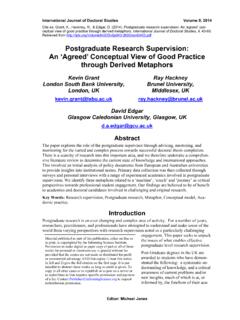Transcription of Vaccine-associated paralytic polio (VAPP) and vaccine ...
1 Fact Sheet February 2015 Vaccine-associated paralytic polio (VAPP) and vaccine - derived poliovirus (VDPV) The oral polio vaccine (OPV) is an extremely safe and effective tool for immunizing children against polio . Over the past 10 years, more than 10 billion doses of OPV have been administered to over billion children worldwide, preventing more than 10 million polio cases during that period. On very rare occasions, OPV can lead to Vaccine-associated paralytic polio or vaccine - derived poliovirus. These are similar but different phenomena.
2 Vaccine-associated paralytic polio (VAPP) OPV is made with live attenuated (weakened) polioviruses that can result in a case of Vaccine-associated paralytic polio (VAPP) in approximately 1 in million doses of OPV. VAPP is caused by a strain of poliovirus that has genetically changed in the intestine from the original attenuated vaccine strain contained in OPV. It is associated with a single dose of OPV administered in a child or can occur in a close unvaccinated or non-immune contact of the vaccine recipient who is excreting the mutated virus.
3 The risk of VAPP varies by dose and by setting. The risk of VAPP from subsequent doses of vaccine is even lower than from the first dose in industrialized countries. This is because in these settings the first dose of OPV stimulates immunity against polioviruses (whether wild poliovirus or the weakened poliovirus contained in OPV). In developing countries, the risk of VAPP is higher from subsequent doses than following the first dose. There are no outbreaks associated with VAPP. The very small risk of VAPP is to the individual susceptible vaccine recipient or close contact.
4 The weakened virus may paralyze the child or his or her contact, but does not spread to cause other cases of paralysis. vaccine derived poliovirus (VDPV) A VDPV is a very rare strain of poliovirus, genetically changed from the original strain contained in OPV. On very rare occasions, under certain conditions, a strain of poliovirus in OPV may change and revert to a form that may be able to cause paralysis (VDPV) in humans and develop the capacity for sustained circulation. The latter is known as a circulating VPDV (cVDPV).
5 Circulating vaccine derived poliovirus (cVDPV) A cVDPV is associated with sustained person-to-person transmission and is circulating in the environment. Persistent cVDPVs refer to cVDPVs known to have circulated for more than six months. cVDPVs are extremely rare. During the last ten years, only 24 cVDPV outbreaks have occurred in 21 countries, resulting in more than 750 cases of paralytic polio . cVDPVs occur when routine immunization or supplementary immunization activities (SIAs) are poorly conducted and a significant proportion of the population is left susceptible to poliovirus.
6 Low vaccination coverage is a major risk factor for cVDPV emergence. A fully immunized population will be protected against both vaccine - derived and wild polioviruses. It takes many months for a cVDPV to emerge. cVDPV outbreaks have the ability to become endemic, can be spread in any under-vaccinated communities, and can be imported to other countries. cVDPVs can be stopped with 2 to 3 rounds of high-quality, large-scale supplementary immunization activities. Outbreak response strategies for cVDPVs and wild polioviruses are the same: immunize every child under the age of five years several times with OPV to stop transmission.
7 Due to the risk of cVDPVs, OPV must be phased out to secure a lasting polio -free world. As wild polioviruses become eliminated, OPV will need to be phased out, starting with the removal of type 2-containing OPV (the trivalent OPV to bivalent OPV switch). Currently, the type 2 component contained in trivalent OPV accounts for more than 90% of all cVDPV cases (bivalent OPV does not contain type 2). Wild poliovirus type 2 has been eradicated since 1999.















